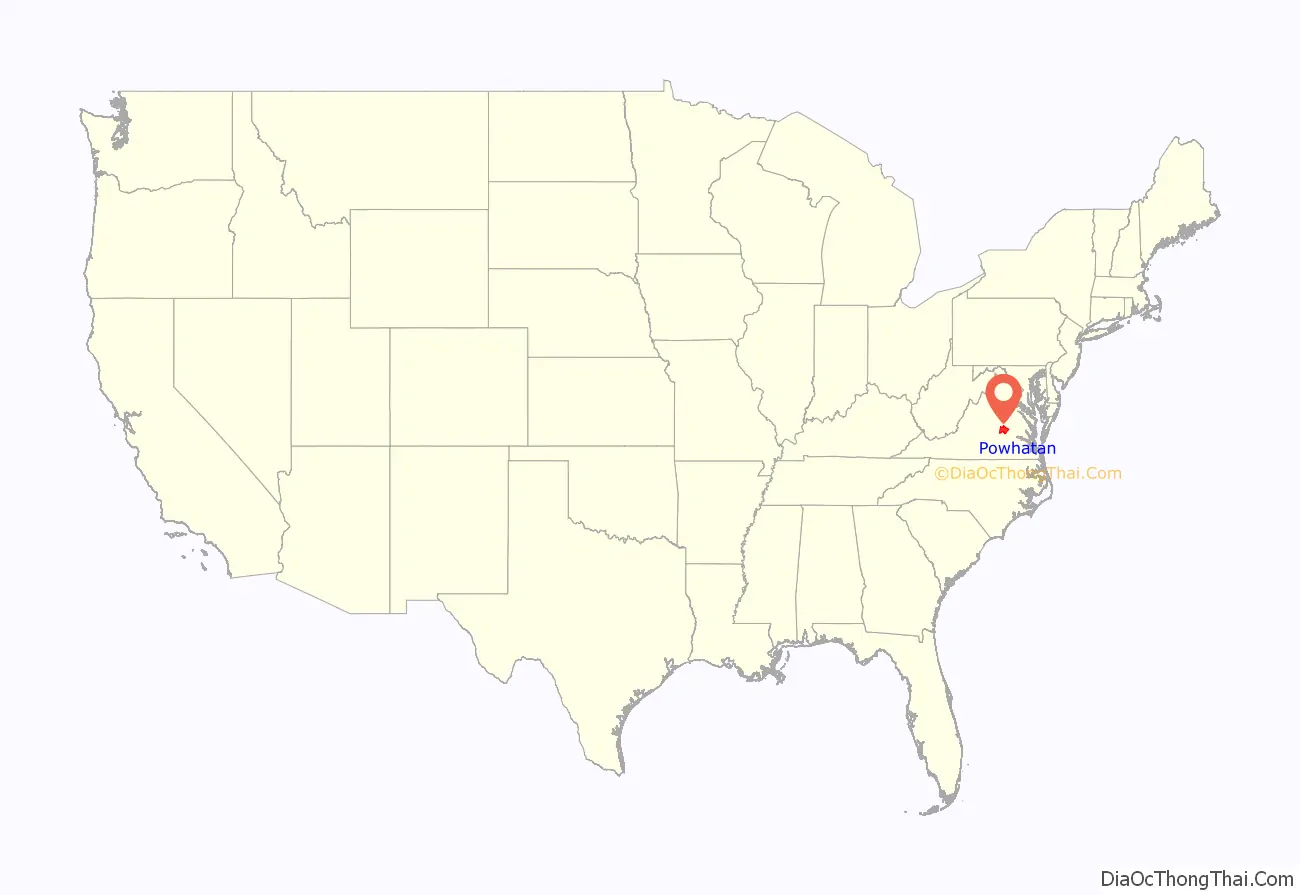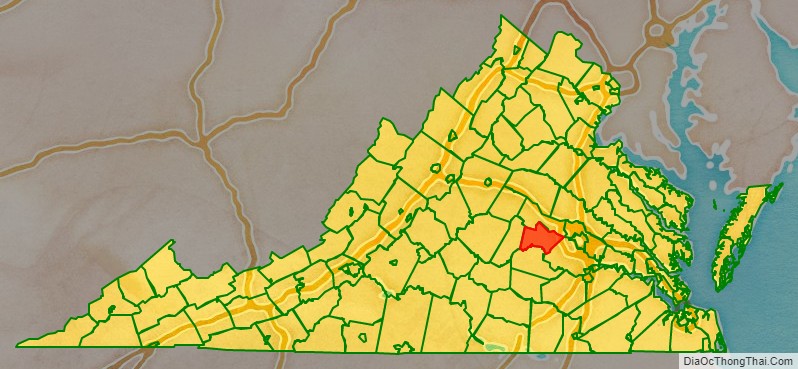Powhatan County (/ˈpaʊ.həˈtæn/) is a county located in the Commonwealth of Virginia. As of the 2020 census, the population was 30,033. Its county seat is Powhatan.
Powhatan County is included in the Greater Richmond Region.
The James River forms the county’s northern border, and the Appomattox River is on the south side. The county is named for the paramount chief of the powerful confederacy of tribes of Algonquian-speaking Native Americans in the Tidewater in 1607, when the British settled at Jamestown. Historically this Piedmont area had been occupied by the Siouan-speaking Monacan. They moved further west, abandoning villages in this area, under pressure from colonists.
In 1700 French Huguenot refugees settled at a Monacan abandoned village, which they renamed as Manakin Town. It was located about 20 miles above the falls on the James River. French refugees also settled on the other side of the river in two villages now known collectively as Manakin-Sabot in nearby Goochland County to the north.
| Name: | Powhatan County |
|---|---|
| FIPS code: | 51-145 |
| State: | Virginia |
| Founded: | 1777 |
| Named for: | Powhatan |
| Seat: | Powhatan |
| Total Area: | 262 sq mi (680 km²) |
| Land Area: | 260 sq mi (700 km²) |
| Total Population: | 30,033 |
| Population Density: | 110/sq mi (44/km²) |
Powhatan County location map. Where is Powhatan County?
History
Mowhemencho Indian village
See Native American tribes in Virginia
Long before the arrival of Europeans in the 17th century, all of the territory of Virginia, including the Piedmont area, was populated by various tribes of Native Americans. They were the historic tribes descended from thousands of years of succeeding and varied indigenous cultures. Among the historic tribes in the Piedmont were the Monacan, who were Siouan-speaking and were recorded as having several villages west of what the colonists later called Manakin Town on the James River.
They and other Siouan tribes traditionally competed with and were in conflict with the members of the Powhatan Confederacy, Algonquian-speaking tribes who generally inhabited the coastal Tidewater area along the Atlantic and rivers feeding it. They also were subject to raids by Iroquois from the north, who were based south of the Great Lakes in present-day New York and Pennsylvania. By the end of the 17th century, the Monacan had been decimated by warfare and infectious diseases carried by the mostly English colonists and traders; their survivors were absorbed into other Siouan tribes.
Manakin Town
In 1700 and 1701, about 700-800 French Huguenot religious refugees on five ships arrived at Jamestown from London, having been promised land grants and settlement in Lower Norfolk County by the Crown. Many of them had been merchants and artisans in London, which was overflowing with refugees from French Catholic persecution after the Revocation of the Edict of Nantes in 1685. Others had found temporary refuge in Holland, Switzerland, Germany, and Ireland. As the tobacco plantations along the James River were dependent upon shipping and water transport, the area in the Piedmont above the head of navigation at the fall line had not yet been settled.
Claiming the Norfolk area was unhealthful (although it became an area of entrepreneurs), Francis Nicholson, governor of the colony, and William Byrd II, a wealthy and influential planter, offered the French refugees 10,000 acres to settle at what became known as Manakin Town, on land abandoned by the Monacan Indians about 20 miles (32 km) above the falls of the James River. They also offered land on the north side of the James River, in what became Goochland County. They wanted the French there as a buffer from Virginia Indians for the English settlements. Byrd also hoped to develop land that he held in that area. The falls area was later developed as the settlement of Richmond, which became capital of the state.
The first years on the frontier were harsh for the urban French; of the 390 French who settled at Manakin Town, only 150 lived there by 1705. The falls on the river prevented them from traveling downriver and the lack of roads mean that they were very isolated, and essentially cut off from the Jamestown settlement. They ran short of supplies, and initially were ill-suited to carve an agricultural settlement from the frontier. They did use some land that had been cleared by the Monacan. Although they had planned to build a town based on the French village model, it proved impractical, as the most fertile land lay along the James River.
So they placed their church and glebe lands in the center of the granted acreage and that became the center for their farms. The grant was divided more or less equally, with each grantee in 1710 receiving about 133 acres, stretching in narrow lots from the river, so that each household would have access to the water. By then, many French families had already migrated to other parts of Virginia and North Carolina. The grants would prove too limited for growing families.
The French became established and assimilated in colonial Virginia; services at the Manakin Episcopal Church (King William Parish) were gradually held more in English than French. The French ultimately adopted the English language and elements of culture, intermarried with many planter families of English descent in the area and to the west, and purchased African slaves as laborers when they could afford them. Many of the Huguenot descendants migrated west into the Piedmont and across the Appalachian Mountains into Kentucky and Tennessee, as did neighboring English colonists, as well as south along the coast, with some ultimately settling in Texas. Today that state has the largest number of members in the Huguenot Society, a lineage association.
Present-day State Route 288 and State Route 711 run about a mile east of the former town. The 1895 Huguenot Memorial Chapel and Monument, the fourth church building constructed there, is maintained by the Huguenot Society. It is listed on the National Register of Historic Places. In addition, the nearby Manakin Episcopal Church, built in 1954, continues full services for a regional congregation.
Powhatan County
In May 1777, the Virginia General Assembly created Powhatan County out of land from the eastern portion of Cumberland County between the Appomattox and James rivers. Residents named the county in honor of Chief Powhatan, paramount chief of the Powhatan Confederacy. He had allied with Algonquian-speaking tribes in the Tidewater, numbering about 30,000 in population at the time of the Jamestown settlement. He was also the father of Pocahontas, whom colonists perceived as friendly. While in captivity, she accepted Christianity and married English settler John Rolfe. Many of their descendants were counted among the First Families of Virginia.
For the first two years after the county was formed, Mosby Tavern served as the Powhatan County courthouse. When a new courthouse was built in 1778, the immediate area was named “Scottville” after General Charles Scott, a Revolutionary War soldier. He was later elected governor of the Commonwealth of Kentucky after it was formed in 1792 as a separate state from land ceded by Virginia. The courthouse area was later named Powhatan.
During the late 18th and early 19th centuries, the county became more developed with expansive plantations as the frontier moved west. Yeomen farmers moved further into the backcountry where land was more affordable. The larger planters used numerous African-American slaves to cultivate and process tobacco, and later mixed crops, including wheat. Even after Reconstruction, Powhatan County used Convict lease to build roads in 1878. The county continued to be organized on an agricultural economy until after World War II. It still has rural areas and historic plantations, but is being developed with suburban residential housing and related retail.
Powhatan County Road Map
Geography
According to the U.S. Census Bureau, the county has a total area of 262 square miles (680 km), of which 260 square miles (670 km) is land and 2.1-square-mile (5.4 km) (0.8%) is water. It is bordered on the north by the James River and on the south by the Appomattox River.
Adjacent counties
- Goochland County – north
- Chesterfield County – east
- Amelia County – south
- Cumberland County – west
- Henrico County – east (easternmost tip of Powhatan touches the southwestern point of Henrico)
Major highways
- US 60
- US 522
- SR 13
- SR 288
- SR 711
- SR 609
- SR 300













